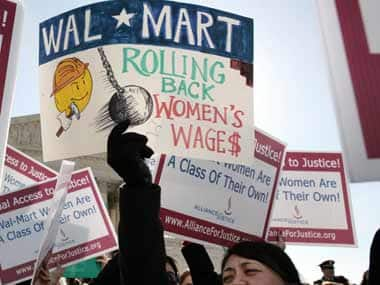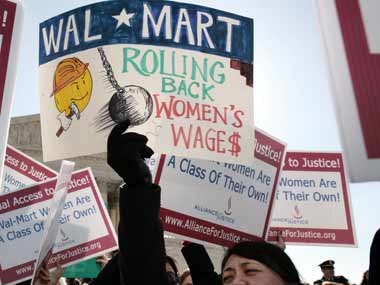The US Supreme Court ruled on Monday in favour of Wal-Mart in the largest workplace sex discrimination case in US history.
The historic case was a class action that involved 1.6 million female employees of the Arkansas-based retailer, the largest private employer in the country. (In India, Wal-Mart runs Best Price Modern Wholesale, which opened its seventh store in Chhattisgarh,on Monday.)
The female plaintiffs in the case alleged that they had suffered discrimination by mostly male supervisors who had passed them up for promotions or who paid them less than the men they worked with. One California plaintiff claimed that she earned less and was disciplined more harshly than her male colleagues; another member of the lawsuit said that her manager “told her to ‘doll up,’ to wear some make-up, and to dress a little better.”
[caption id=“attachment_28560” align=“alignright” width=“380” caption=“Is Wal-Mart too big to be held accountable? Some observers worry that the US Supreme Court ruling in the corporate giant’s favour in an historic class action sexual discrimination suit sends out that message. Larry Downing / Reuters”]
 [/caption]
[/caption]
As a class action case, the lawsuit was filed on behalf of all people who are affected by the same legal question (similar in some respects to India’s Public Interest Litigation).
In its 5-4 decision, the High Court did not actually rule on whether female Wal-Mart workers had been discriminated against or not. Instead, they focussed on whether or not the lawsuit should have been granted class action status.(For more on why, see the “The legal jargon” section at the tail-end of this post.)
In the end, the size of the class was the case’s undoing.“The Supreme Court has basically said this is too big a case,” said Jeffrey Toobin , CNN’s senior legal analyst. “The facts are so different regarding each of the plaintiffs that it’s not fair to Wal-Mart to lump them into one case.”
Impact Shorts
More ShortsBut several Democratic politicians have assailed the decision. Sen. Patrick Leahy, a Democrat from Vermont, said in a statement that “[t]oday’s decision will undoubtedly make some wonder whether the Supreme Court has now decided that some corporations are too big to be held accountable.”
A boon for corporations, employers
For the female plaintiffs in the lawsuit, the decision means they’ll have to regroup and find another way to bring their claim-perhaps through smaller class actions by region or store.
Legal observers, meanwhile, say that the case will have rippled effects on class action litigation of all stripes, from securities to product liability cases. The decision could have a legal benefit to corporations and employers accused of wrongdoing.
Charles Smith, a securities litigator at Skadden Arps, told the Wall Street Journal that the majority opinion will be a “helpful tool for defendants to limit the scope and costs of these expensive cases.”
Wal-Mart in India
With less of its funds tied up in defending a massive lawsuit, Wal-Mart may now be able to invest more in its global business in India and elsewhere.
Wal-Mart has pegged a significant portion of its future growth on the Indian market, and it has avoided India’s restrictions on foreign direct investment (FDI) for multi-brand retail by running a cash-and-carry venture in conjunction with Bharti Enterprises.
Though the company may be hopeful that the legislation that would loosen FDI laws will pass, Doug McMillon, the president and CEO of Wal-Mart’s international division, nonetheless told CNBC-TV18’s Shereen Bhan in a Monday interview that the company is “in for the long run” when it comes to investing in India.
“We are committed to India,” he told Bhan. “I think the question will be how much capital do we invest, and how soon and that will be driven by this decision that you are referring to.”
The legal jargon
What was the reasoning behind the US Supreme Court ruling?
All nine justices agreed that this case was inappropriate for class certification because of the plaintiffs’ demand for backpay, which the Court decided would strip Wal-Mart of its rights to defend these kinds of claims individually.
But the justices disagreed on the issue of “commonality,” or whether there was enough similarity between the 1.6 million women to allow the case to move forward as a class action.
Statisticians and labour economists who served as expert witnesses for the plaintiffs found that:
• Women fill 70% of the hourly jobs in the retailer’s stores but make up only “33% of management employees.”
• Female employees at Wal-Mart “are paid less than men in every region.”
• The “higher one looks in the organisation, the lower the percentage of women.”
• Wal-Mart promotes a lower percentage of women than its competitors.
However, for the majority of justice, these experts did not establish “the existence of a common question” with these statistics.
As the justices wrote in the majority opinion:
We agree with [Ninth Circuit Court of Appeals] Chief Judge [Alex] Kozinski that the members of the class: ‘held a multitude of different jobs, at different levels of Wal-Mart’s hierarchy, for variable lengths of time, in 3,400 stores, sprinkled across 50 states, with a kaleidoscope of supervisors (male and female), subject to a variety of regional policies that all differed… Some thrived while others did poorly. They have little in common but their sex and this lawsuit.’
The four justices in the minority argued that sufficient commonality did, indeed, exist. The Ninth Circuit court, recognising that “one significant issue common to the class may be sufficient to warrant certification…found that the plaintiffs easily met that test,” Justice Ruth Bader Ginsburg wrote in the dissenting opinion, and that question is whether Wal-Mart disfavours female employees in promotions and pay.
Despite the corporate policy that forbids discrimination of any kind, the “plaintiffs’ evidence, including class members’ tales of their own experiences, suggests that gender bias suffused Wal-Mart’s company culture,” Ginsburg wrote.
)